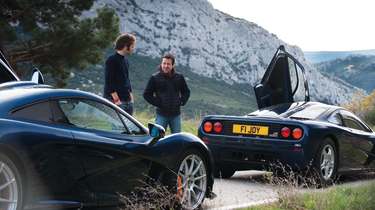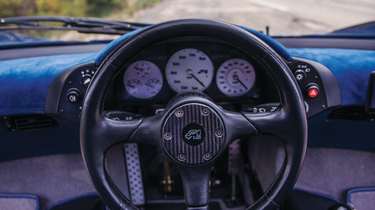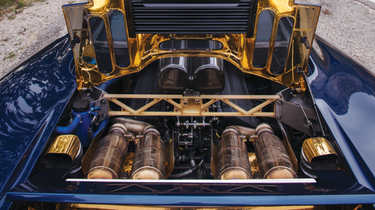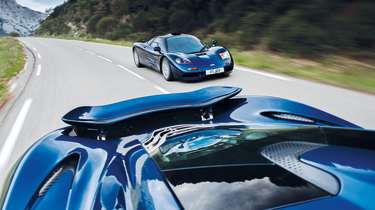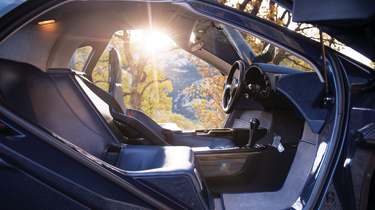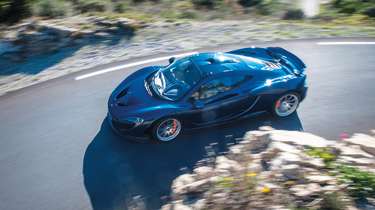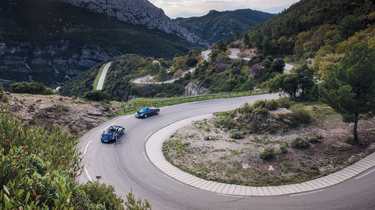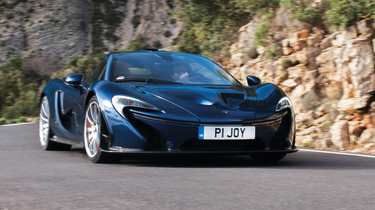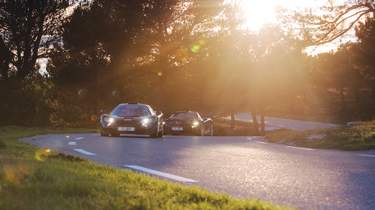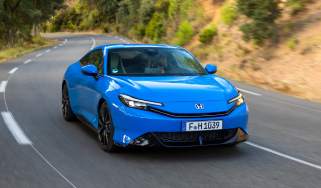McLaren F1 v McLaren P1: British hypercar icons go head-to-head
F1 and P1. Separated by two decades but united by a simple aim: to provide the ultimate, money-no-object driving experience... and together on the same roads. So which serves up the bigger thrill? We’re about to find out
A roller shutter door clatters into life and the anonymous building’s grey façade opens to reveal its secret. At first you can’t quite believe what you’re seeing. Shining beneath the harsh strip-lights are two McLarens, painted in an identical shade of Genesis Blue, wearing matching registration plates and, we’re told by the owner, bearing the same #046 chassis number. If it weren’t for the biting December wind making me wish I’d brought a sturdier jacket, I’d swear it was an especially vivid dream.
We step inside from the cold. Immediately before us sits the P1, behind it the F1: Old and New Testament supercars that bookend McLaren’s greatest road-going achievements. When you’re in the presence of these cars few words can hope to do them justice, so after a peel of spontaneous ‘wows’ and ‘phwoarrs’ the space is filled with a deep, church-like silence as we pay reverential respect and get lost in the thought that for the next few days these dazzling machines are at our disposal.
> McLaren F1 (1994 - 1998): driving the 240mph hypercar icon
Which to drive first? I’m in the blessed position of having driven both F1 and P1 before, so the impulsive urge for a fresh experience is replaced by the more pragmatic need for context on which to base this story. As there’s no greater frame of reference for the modern supercar than the McLaren F1, it’s the old icon that gets the nod.
More reviews
Group tests
- Alpine A290 v Alpine A110 – how much DNA do they really share?
- Ariel Atom 4R v Caterham Seven ‘evo25’: power-to-weight heroes go head-to-head
- Ariel Atom 4 v Caterham Seven 310R v Lotus Elise Cup 250
- £200,000 supercar shoot-out: AMG v Aston Martin v Maserati v McLaren
- Who makes the best GT car? Aston Martin v Bentley v Maserati
- Caterham Super Seven 600 v Super Seven 2000
- Corvette Stingray v Porsche Cayman GTS v Audi R8 RWD
- Volkswagen Golf GTI Clubsport v Cupra Leon 300 – what's the best mainstream hot hatch?
- Great Ferrari hypercars driven: 288 GTO, F40, F50 and Enzo head-to-head
- GMA T.50 v McLaren F1 – has the best car in the world been dethroned by its successor?
In-depth reviews
- Abarth 600e 2025 review – Italy gives the Alpine A290 something to worry about
- Alpine A110 review – the sports car Lotus should be building
- Aston Martin Vantage 2025 review – a thrilling Mercedes-AMG GT and 911 Turbo S alternative
- Used Audi RS2 (1994) review – an unsung '90s hero you can own for £40k
- Audi R8 (2015 - 2024) review – the ultimate soft-focus supercar
Long term tests
- Abarth 695C Turismo Fast Fleet test – living with the charming Italian hatch
- Alfa Romeo Giulia Veloce Fast Fleet test – living with the sharp Italian saloon
- Alpina B10: end of term report
- Alpina B10
- Aston Martin Vantage (2006) Fast Fleet test – living with a £30k V8 Aston
- Caterham Seven evo25 Fast Fleet test – living with a track car for the road
- Caterham Seven evo Edition revealed – bespoke 420R joins the Fast Fleet
- Cupra Ateca VZN Fast Fleet test – four months with Cupra's hot crossover
- Cupra Leon Estate 310 4Drive Fast Fleet test – living with the 306bhp hot estate
- Ford Mustang GT
Review
- New Bentley Batur 2023 review – can it possibly be worth £1.65m?
- 2023 Chevrolet Corvette C8 Z06 review – the American 911 GT3?
- BBR Supercharged Mazda MX-5 (ND) 2023 review – tuned 250bhp roadster driven
- MG4 Trophy 2023 review
Reviews
- Abarth 695 75 Anniversario edition 2024 review – a fitting send-off for Abarth’s hot supermini?
- Abarth 500e 2023 review
- AC Cobra 378 Superblower MkIV 2021 review – another V8 Cobra, but with a GM heart this time
- Acura Integra Type S 2024 review – a Honda Civic Type R with added restraint
- Alfa Romeo Giulia 2025 review – get one while you still can
- Alfa Romeo 33 Stradale 2025 review – a rare Italian jewel beyond compare
- Alfa Romeo SZ: history, review and specs of an icon
Small, sleek and slim-hipped, with a smattering of intakes and vents and a complete absence of wild, look-at-me wings, the F1 is an exercise in modesty, purity and purpose. To my eyes the older it gets the better it looks, its proportions and simple detailing creating a shape that’s impossible to ignore. Tentatively reach out to press the polished, puck-like door release and, once the latch has popped, you can tuck your fingers beneath the trailing edge of the door to help it on its way until the gas strut takes it up and out of your hand with a soft hiss. Your body tingles with apprehension and a mild, sharpening hit of adrenalin.
We all know the F1 has three seats, but to peer in and see that famous central driver’s seat remains a sacred moment, especially when it’s you that will shortly be ensconced behind the wheel. The driver’s handbook devotes several pages to the correct method of ingress and egress, but to be honest you could crawl in on your hands and knees and still be one of the cooler people on the planet. When you finally drop into the seat – always from the left-hand side to avoid snagging yourself on the gearlever – there’s a lot to take in. Not least the glorious, panoramic view through the windscreen. But there’s much more to the F1’s cockpit than just sitting in the middle.
It’s the details that provide endless delight. The ignition key that slots into the chassis plate and the unassuming red starter pip hidden beneath a flip-top guard. The square reverse detent slider that makes three-point turns such a fiddly but uniquely meticulous process. The beautifully simple steering wheel with its two paddles on the rear of the spokes: headlight flasher paddle on left, horn on right. The slightly incongruous wood on the handbrake grip that lends it the look and feel of a handgun, and the smooth, spherical gearknob that fills your right palm perfectly. Glance up to the header rail and instead of one central rear-view mirror there’s a pair; one to the left and one to the right, just like a fighter jet. Immediately ahead are the beautiful black-on-white dials – large central tacho flanked on the right by the modest, but epic, 260mph speedo. Turn on the headlights and they’re bathed in a spectral green glow.
Don’t waste your time looking for the Sport button or the damper settings or even traction control because there aren’t any. Nor is there any power assistance for the steering or the brakes. This is a car in which you have to configure your head to suit the car, not vice versa. After a suitably meaningful pause in which you weigh up the temptation about to be put your way against the F1’s c£10million market value, you twist the key 90 degrees clockwise, listen to the busy buzz of solenoids and pumps, then nudge your finger beneath the small black anodised guard and press the little red button. After the briefest of click-whirrs from the starter motor, Paul Rosche’s masterpiece awakens bright and instantaneous, like an incandescent lightbulb. After clearing its throat with a sharp pulse of revs, it settles into a busy, superbike-like idle.
The clutch is weighty and the gearlever moves with a slightly gristly action as you pull left and push forwards for first gear. It’s best to resist the temptation to so much as tickle the throttle when introducing the F1’s eye-wateringly expensive clutch plates to the flywheel, for the revs leap like voltage through copper wire. Better to take your time and gently start rolling on tickover before squeezing the throttle once the clutch is fully engaged. The F1 might be one of the world’s fastest supercars, but it would make a rubbish getaway car.
The BMW Motorsport-built V12’s urgency is the stuff of legend – a legend it never fails to live up to. Today’s hypercar obsession is torque- fill from batteries, but the F1 prefers 6064cc of naturally aspirated internal combustion to any amount of lithium-ion witchcraft. No other road-car engine combines its immediacy, reach or big-cube bombast. A Carrera GT’s V10 feels thin by comparison, a Zonda’s V12 a bit flabby. Its sharpness and ferocity are sensational, each millimetre of throttle travel yielding mighty, perfectly metered force. Though the bald figures might suggest otherwise, when it comes to explosive in-gear response, nothing talks the torque like 1137kg thrown down the road by 479lb ft. And as for the noise it makes, well, it’s 30 per cent Stradivarius, 70 per cent wild, carnivorous animal.
Just as the V12 yelps at the slightest whiff of throttle, so the revs die immediately when the right-hand pedal is snapped shut. The motor’s minimal inertia is one of the F1’s great joys, but it’s also one of its greatest challenges, because the slightest hesitation when you change gear can leave you becalmed. Consequently each gearchange requires sharp, positive inputs, but you can’t just smash it through. It needs guiding if you’re to avoid getting tangled on the way across the gate. It’s a perfect case of hurry up and wait. Sometimes you can snick through half-a-dozen peachy shifts – at which point you’re feeling pretty bloody good about yourself – but then you’ll fluff one and you’re immediately knocked down a peg or two.
The steering weight is a bit of a shock, especially in tighter bends (and this F1’s seems heavier than others I’ve driven), but when you’re up and running most corners are dispatched without needing to work the wheel more than half-a-turn either side of straight-ahead. The upside of the physical effort is that it serves to heighten the experience, for it magnifies the feel, precision and perfectly judged rate of response. There’s a harmony between the controls and the way the F1 likes to be guided. It takes some mental and physical adjustment to become comfortable and confident with its preferred style but, when things begin to click, no other car in my experience rewards effort and growing familiarity so richly.
The weight of the steering and the measured rate of response it elicits means you can’t immediately overwhelm the front end on turn-in, as you can in a car with power-assisted steering. That’s not to say you can’t hustle the F1, indeed it means you can do just that, working towards the limit of grip rather than charging straight through it and working back from there. Steering effort increases with lock, as does the body roll, but it all helps build a precise tactile picture of where the limit lies. In slow corners you can lean on the front end until you feel the nose just begin to run wide. Through faster corners you only need small squeezes of lock, politely coaxing rather than cajoling the F1 to follow your chosen trajectory.
So you can place the car exactly where you want it and judge gaps to perfection, but what you can’t do is take liberties. The F1 rolls and dives and squats in a manner that’s anathema to today’s tied-down hypercars. It works in partnership with the road, rather than treating it with disdain, and this means you need to be aware of cambers, crests, surface changes and lingering patches of damp that might upset the finely balanced division of labour between the rear Michelins. It’s not uncommon to hear and feel the revs flare in a straight line, but in the dry at least you can trust it to stay straight and true. The F1 is an altogether more prickly beast in the rain, but today – thankfully – the gods are smiling on us.
While the F1 has a justified reputation for biting its owners, it never does anything it hasn’t warned you about. Once you’ve applied some steering lock, felt the front end work towards its limit of grip and the body begin to roll as lateral loads increase, you soon learn that an additional squeeze of throttle will readily break traction out of slow corners. The first time it happens triggers an involuntary spasm of fear, but the abundant torque means you can keep the rear wheels over-rotating at modest revs and throttle openings, so it’s not the knife-edge process you’d imagine. But you do need to be smooth and swift when unwinding the lock.
Things are different at higher speed. You still need to use the building body roll as a guide to how hard the car is working, especially at the rear end, which famously does without an anti-roll bar. Appreciate the Laws of Physics and understand that 20-year-old supercars prefer not to be asked more than one question at a time and all will be well. Drive it like a Nissan GT-R (or indeed a P1...) and there’s a very real chance you’ll be ruining your underwear and your insurance underwriter’s year.
As with the on-limit handling, the brakes require a certain sympathy for and empathy with the machinery. You don’t get the initial confidence-inspiring bite of a servo-assisted set-up, nor the tireless stamina of carbon-ceramic discs, but there’s unique linearity to the relationship between pedal pressure and stopping power. The harder you push, the better you stop. Ultimately, retardation isn’t at the level you’d expect for a 240mph car, but at more reasonable velocities they’re effective enough to keep you out of trouble if you’re prepared to temper your desire to steam into every corner hell-bent on braking at the last possible moment. Interestingly, all F1 brakes squeal like pigs, which always amuses me given McLaren’s obsession with perfection.
You sit low in the F1. If you happen to be following a P1, that means you find yourself staring right into the mouth of that flame-thrower exhaust. It’s a terribly distracting car to chase. You can see lots of mechanical gubbins – fan housings, cables and hydraulic rams – all proudly displayed behind intricate webs of fine mesh. To uninformed eyes I’m sure it’s all a bit of a mess, but to our eyes it’s a techno peepshow. The huge rear wing remains stowed in the P1’s mildest modes, but when the aero mode is active the big, sculpted aerofoil sits proud, fidgeting and twitching in an effort to pluck increased stability from thin air. Meanwhile, as speed builds, the diffuser sucks enough road detritus to form a visible plume of chippings and pine needles at speed. When the windscreen you’re sitting behind costs a rumoured £15,000, it’s best to keep your distance, but even then the P1 continues to put on a show, its red LED tail lights forming unmistakable scarlet ciphers burning bright in the distance.
It’s fascinating to watch the P1 make progress. Forget the tyre-smoking, flame-throwing wild thing you know from countless YouTube videos: it’s a very different animal on the road. The way it rotates into corners is startling, its nose cutting towards the apex with an impatience that’s breathtaking to witness. It works both ends of the car equally hard, apparently almost teetering on the edge of instability as the tail chases each direction change. When the road opens out, it punches down the straights, wriggling and squirming as the meat of the boost hits home, then bundles into the next sequence of corners, braking late and deep into the heart of the turn yet still able to remain stable and manage a flurry of downshifts.
It might look like an alien craft from the outside, but its driving environment is inherently more conventional. Yes there are endless organic contours wrought from satin-lacquered carbonfibre, and the facia dances with bright electronic displays, but, after the F1’s central driving seat, being shoved to the left feels like a bit of a downgrade. At first you can’t seem to shift the chunky left-hand A-pillar from your peripheral vision. It’s a bit like wearing a blinker, especially when looking through a long left-hand corner, but you do learn to adjust. In every other regard the P1 is a cinch to operate, thanks to light, quick-witted controls and the idiot-proof paddleshift transmission.
On start-up the twin-turbo V8 is a far more gruff-sounding device. Deep and resonant at idle, it trades modest musicality for no-nonsense potency, but a light dab of brakes and – as is McLaren’s way – a click of either paddle (pull back on the right-hand paddle, or push the left one forwards if you prefer shifting southpaw), followed by a smooth squeeze of throttle is all you need to get this 900bhp hypercar moving.
The lightness and response of the steering is startling. After the F1, which required you to use shoulders and forearms, it takes considerable self restraint to use your wrists and fingertips, but once you’ve got the measure of the major controls there’s considerable satisfaction to be had from the clean, surgical manner in which the P1 makes progress.
It’s a surprisingly noisy car to be in. Road- noise thrums around the cockpit, the clatter of the odd stray chipping reminding you of the P1’s carbon construction. However, the main source of noise is the engine. There’s an apparently endless repertoire of grisly, respiratory coughs, gurgles and hisses as turbo boost ebbs and flows. Depending on your mood, it can be tremendously exciting or rather annoying, but it does make the P1 feel like its coming to life beneath your right foot. The familiar Active Dynamics panel controls the powertrain, chassis and aero settings, which you can tweak to suit the road and your intended pace. It’s astonishing to feel how the car responds to the settings: pliant and mellow one minute, urgent and iron-fisted the next, but as a result you do tend to find yourself fiddling and tweaking.
It’s the modern way, and it surely expands the P1’s breadth of abilities on road and track, but after the simplicity of the F1 and the satisfaction you derive from knowing it’s you that needs to adapt to the road and conditions, the P1’s constant craving for input and adjustment can make it feel a little needy.
Retracing our steps up into the mountains soon shows just how different an animal the P1 is to the F1. It takes a while for the penny to drop but, when you decide to go for it, you drive the P1 in a more binary fashion. Punching down straights in a flurry of upshifts, diving into the heart of the corners with another handful of downshifts (even as you’re getting the car turned-in), immediately focused on launching out the other side, allowing the stability control to nip and nudge at wheelspin in the traction zones before releasing you onto the next straight.
It shouldn’t come as a surprise, but it’s like a modern slicks-and-wings racing car: designed to interpret any given road in a ruthless, geometric manner that gets you into and out of any given corner in the most direct way possible. It’s in stark contrast to the more classical style of the F1, which demands you scribe smooth, flowing lines, brake in a straight line and get your downshifts done well before you need to make your steering inputs.
Driving a fully lit P1 has been likened to riding a firework. It’s intense and exhilarating and, if you attempt to deploy the IPAS battery boost or trigger the DRS system, a stern test of your ability to multi-task. Of course both are gimmicks, but I’d be lying if I said there isn’t endless fun to be had from feeling the surreal thump of battery power supplementing the on-boost V8. It’s genuinely like you’ve pressed the fast-forward button. Likewise, using the DRS button to wave bye-bye to whatever’s in your mirror is childishly amusing. Who says McLaren doesn’t have a sense of fun?
As you’d expect, the P1 walks inexorably away from the F1 whenever you put your mind to it. Beyond the fact that you have more grip, power and torque to exploit, you simply don’t need to exercise the same degree of caution or leave the same margins as you do in the F1. Interestingly, when the road is tight and twisty, the P1 can’t match the F1 for initial snap out of the hairpins, but once the boost hits home it finds its feet and wins back some lost ground.
It goes without saying that on a circuit the F1 would be left floundering, but then it was never conceived as a track car, which is ironic given its outright win at Le Mans in 1995. Thanks to advances in suspension and aerodynamic technology, the P1 makes a better fist of being a road car than the F1 does being a track car, but still there’s no doubting the full P1 experience can only be accessed in Race mode on a circuit.
I won’t insult your intelligence (or these remarkable cars) by glibly declaring a winner, not least because the F1 has reached a stage where it transcends conventional comparison. If you had the means, you could quite easily justify owning both, such is the gulf between the driving experiences they deliver. The truly remarkable thing about the F1 is just how far in advance it was of every other supercar when it was launched. It literally made a mockery of the established names, immediately assuming a position of pre-eminence. There have been pretenders, but never anything you could describe as a credible rival. Faster and more powerful? Yes. More flamboyant? Certainly. But more complete? More pioneering? More engaging? More pure? Never.
By contrast, the P1 was being compared to rivals from Porsche and Ferrari even before they were launched. That’s as much a reflection of the P1’s role in McLaren’s quest to be a major player and sell thousands of cars a year as it is testament to the unique circumstances that brought about the F1. Still, the differences between the F1 and P1, both in aspiration and achievement, are so stark they make chalk and cheese seem like closer bedfellows. If you happen to be McLaren, striving for a new four-wheeled superlative, the F1’s legacy is surely as much a curse as it is an inspiration.
That said, I’d bet my life that if any of you drove a P1 you’d be totally gobsmacked by the scale, ferocity and accessibility of its performance, the sophistication of its delivery and the rawness of its character. Yet, for all that, to drive an F1 is to experience something truly exquisite. To spend enough time with one to have precious, fleeting moments where you’re driving it well is to have a taste of what it’s like to be Viv Richards when he picked up a cricket bat or Eric Clapton when he plays guitar. The P1 is a remarkable car, bold and brilliant in so many ways, but the F1 is a freakish work of true genius and an impossible act to surpass.
This story was first featured in evo issue 205.
